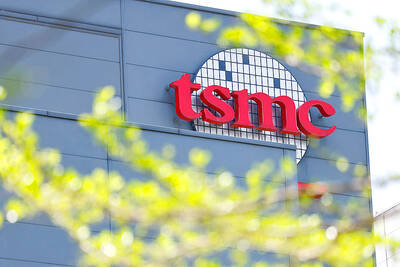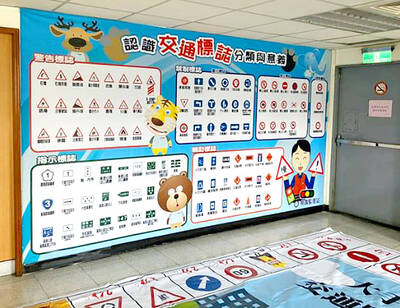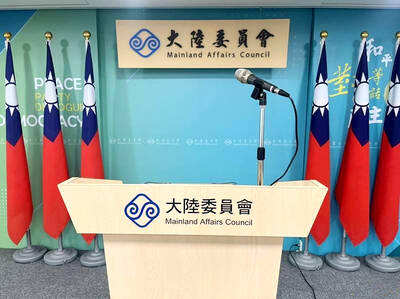Despite the rapidly slowing economy, an army of cranes still moves busily above the archipelago of factories that Sharp is building in the gritty port of Sakai.
The US$10 billion complex, row upon row of hangar-size buildings, will produce up to 13 million liquid-crystal-display TVs a year by 2010.
If consumer demand does not rebound by then — and if prices for flat-panel sets do not stop falling — analysts say the project could end up being little more than the world’s most expensive industrial art installation. But the Japanese TV maker calls it something else: one of the keys to its survival, particularly in hard times.
“We need to take a longer-term view,” said Nobuyuki Sugano, an executive at Sharp. “If other companies slow down spending, we can stay ahead.”
Global companies are battening down the hatches — reducing spending, laying off workers and pulling back on luxuries like research and development and expansion. In the US, many seemed to support letting the automobile industry collapse under the weight of its own lethargy.
Japanese companies are also cutting back — on Dec. 10, Sony announced it would eliminate 8,000 jobs. But, armed with the lessons of their past, many Japanese companies are cutting back less than their competition, investing instead for the day the downturn ends, however long that takes.
“Unless our sales dry up completely, we have to continue investing,” said Kumiko Makino, a spokeswoman for Sanyo Electric, which has refused to cut investment in new battery and solar panel factories. “If we stop, our rivals and competitors will quickly catch up.”
That urgency stems from the bitter lessons of the stagnant 1990s. Japanese companies cut back on development, only to lose ground to hungry Taiwanese and South Korean competitors.
Many economists and industry analysts say Japanese companies have so far maintained higher levels of investments in production, research and development than companies in other countries.
Instead of huge layoffs or cuts in operations, firms are cutting part-time staff members. (Layoffs of full-time workers remain taboo.) They are also delaying or canceling fewer new plants than elsewhere.
One reason is that Japanese companies have war chests of cash built up during Japan’s recovery earlier this decade. Another is that unlike in the US, shareholders lack the power to demand that cash be paid out as dividends. If Japan’s powerful manufacturing sector has a secret to its success, it may be this willingness to reinvest a big share of profits back into new plants and research.
Japan’s drive to build bigger, more advanced factories fueled an industrial construction boom that propelled the economic recovery earlier this decade. It also equipped the nation with the most advanced factory production lines to try to defend its technological lead over the rest of Asia.
“Japan sees its future as more dependent on capex than Americans or Europeans do,” said Robert Feldman, an economist at Morgan Stanley in Japan, using the industry jargon for “capital expenditure,” investment in new factories and equipment.
Innovation grew from necessity, too. Feldman noted that with Japan’s shrinking population, companies are more likely to try to fill the gaps by investing more heavily in labor-saving machinery, like robots.
To be sure, the global slowdown has hammered Japan’s profits and sent its US$5 trillion economy, the world’s largest after the US, into recession. And economists say harder times lie ahead, with the US’ crucial Christmas shopping season looking to be one of the weakest in memory.
Overall, government figures released last month reported that corporate spending on factories and other facilities fell 2 percent in the three months ending in September from the previous quarter, for its third consecutive quarterly decline. The declines were a major factor in Japan’s sliding into recession.
Tetsufumi Yamakawa, chief Japan economist at Goldman Sachs, estimates that such investment will shrink 1.8 percent this year and 2.1 percent next year before growing slowly.
“The pace of the slowdown in capex has been much sharper than we expected,” he said.
Still, Yamakawa and other economists say they expect corporate Japan to keep outspending the US on new factories, even during the current downturn.
Last year Japan spent 16 percent of its GDP on new factories and production, Yamakawa said. While that is down from Japan’s high-growth 1980s, when it spent closer to 25 percent, the figure is still high when compared with 11 percent by the US, he said.

EUROPEAN TARGETS: The planned Munich center would support TSMC’s European customers to design high-performance, energy-efficient chips, an executive said Taiwan Semiconductor Manufacturing Co (TSMC, 台積電), the world’s largest contract chipmaker, yesterday said that it plans to launch a new research-and-development (R&D) center in Munich, Germany, next quarter to assist customers with chip design. TSMC Europe president Paul de Bot made the announcement during a technology symposium in Amsterdam on Tuesday, the chipmaker said. The new Munich center would be the firm’s first chip designing center in Europe, it said. The chipmaker has set up a major R&D center at its base of operations in Hsinchu and plans to create a new one in the US to provide services for major US customers,

The Ministry of Transportation and Communications yesterday said that it would redesign the written portion of the driver’s license exam to make it more rigorous. “We hope that the exam can assess drivers’ understanding of traffic rules, particularly those who take the driver’s license test for the first time. In the past, drivers only needed to cram a book of test questions to pass the written exam,” Minister of Transportation and Communications Chen Shih-kai (陳世凱) told a news conference at the Taoyuan Motor Vehicle Office. “In the future, they would not be able to pass the test unless they study traffic regulations

BEIJING’S ‘PAWN’: ‘We, as Chinese, should never forget our roots, history, culture,’ Want Want Holdings general manager Tsai Wang-ting said at a summit in China The Mainland Affairs Council (MAC) yesterday condemned Want Want China Times Media Group (旺旺中時媒體集團) for making comments at the Cross-Strait Chinese Culture Summit that it said have damaged Taiwan’s sovereignty, adding that it would investigate if the group had colluded with China in the matter and contravened cross-strait regulations. The council issued a statement after Want Want Holdings (旺旺集團有限公司) general manager Tsai Wang-ting (蔡旺庭), the third son of the group’s founder, Tsai Eng-meng (蔡衍明), said at the summit last week that the group originated in “Chinese Taiwan,” and has developed and prospered in “the motherland.” “We, as Chinese, should never

‘A SURVIVAL QUESTION’: US officials have been urging the opposition KMT and TPP not to block defense spending, especially the special defense budget, an official said The US plans to ramp up weapons sales to Taiwan to a level exceeding US President Donald Trump’s first term as part of an effort to deter China as it intensifies military pressure on the nation, two US officials said on condition of anonymity. If US arms sales do accelerate, it could ease worries about the extent of Trump’s commitment to Taiwan. It would also add new friction to the tense US-China relationship. The officials said they expect US approvals for weapons sales to Taiwan over the next four years to surpass those in Trump’s first term, with one of them saying